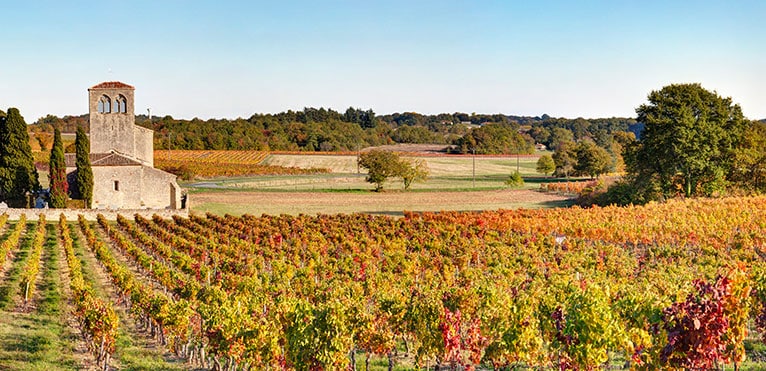
Contents
Pécharmant is an appellation in southwestern France, an integral part of the Bergerac region. The oldest vineyard in the Bergerac region, its vines are planted on the right bank of the Dordogne, and its winegrowers produce only a remarkable long-keeping red wine. In the heart of Périgord, the appellation’s terroir extends over 4 communes: Lembras, Saint Sauveur, Bergerac and Creysse. Pécharmant is classified as an AOC, a French label designating an appellation d’origine contrôlée. It is also classified as a PDO, a European label designating a protected designation of origin.
Pécharmant is an appellation nestled on the slopes of the Dordogne river.
As a wine from the Bergerac region, Pécharmant shares much of its history with other regional appellations. The vineyard has been present since the 11th century, making it the oldest in the region. In 1080, the monks of Saint Martin de Bergerac cleared the land on the right bank of the Dordogne to the north, formerly known as “la vinée Nord”. Pécharmant” means “charming hill” in Occitan, and the vines of these hills are the primary source of their liturgical wines.
After the Hundred Years’ War, the Huguenots living in the region went into exile in Holland. A wine trade flourished between the Bergerac region and the Netherlands. Pécharmant and Bergerac wines earned their letters of nobility during the “Dutch century” between 1650 and 1750.
The 19th century saw phylloxera (a parasite) devastate the entire Pécharmant vineyard. It wasn’t until 1943 that a winegrowers’ union was formed. In 1946, they were awarded the appellation d’origine contrôlée. Today, nearly 50 producers work in the appellation and must respect the charter.
A small vineyard with many grape varieties typical of the region
The appellation’s vineyards cover 435 hectares. It lies to the north-east of the Monbazillac vineyards and to the south-east of those of the Rosette appellation. The terroir benefits from a temperate oceanic climate. Thanks to hemicyclic, south-facing vines, the grapes benefit from optimum sunshine to concentrate aromas and sugars.
With altitudes of up to 150 meters, one of the vineyard’s special features is the composition of its soils. The soil on the hillsides is composed of Périgord sand and gravel. The subsoil is composed of limestone enriched with iron and clay, and a deep layer known as “Tran”, which gives Pécharmant its distinctive taste.
The main grape varieties used are Cabernet Sauvignon, Cabernet Franc, Malbec and Merlot. Planting density must be at least 4,000 plants/hectare. Alcoholic strength must be between 11.5% and 13.5%.
How to drink a Pécharmant
Pécharmant vineyards produce exclusively red wines. They are all blends of Cabernet Franc, Cabernet Sauvignon, Malbec and Merlot. Serve this wine at a temperature of 16° to 17°C, if possible with prior aeration in a carafe. The color is a deep garnet-red with purplish highlights, tending towards tile-like hues as it ages. The nose offers aromas of wild berries such as raspberry or redcurrant. Aeration reveals notes of roasting, cocoa and vanilla. With age, it acquires animal notes. It leaves a singular first impression on the palate: both powerful and straightforward, it offers dense, deep substance. Its tannic structure is firm and the finish expresses itself on notes of liquorice. As a vin de garde, you can wait an average of 3 years before drinking this wine, but it can be kept for up to 15 years for the greatest vintages.
What dish to serve with a Pécharmant for a successful wine pairing?
Specialists usually compare the greatest vintages of Pécharmant with Saint-Emilion or Pomerol. That’s why fine gourmets will appreciate a Pécharmant with red meats and roast game. It can also be paired with white meats such as rabbit, seasoned with a few mild spices.
2009, 2010 and 2016, great vintages at Pécharmant
The 2009 vintage was a very fine year for the Pécharmant appellation and for all the wine-growing regions of south-western France. The mild spring, combined with the warm weather and well-distributed rainfall, enabled us to harvest both quality and quantity. This gave rise to great, concentrated and complex red wines. The 2010 and 2016 vintages were also fine years for the appellation, producing beautiful, rich wines of remarkable finesse.
For the best years, a Pécharmant wine can be kept for up to 15 years.
Where is the best producer to buy Pécharmant?
Château Terre Vielle
The château’s first vines were planted in the 18th century, but it wasn’t until 1989 that the Pécharmant winegrowers, the Morand Monteil family, took over viticulture on these Périgord lands. Today, the 13 hectares of vines are devoted to the production of Pécharmant appellation wines. The wine is traditionally aged in French oak barrels. The careful work of the winemakers led to a silver medal in 2017 for the Pécharmant Château Terre vieille 2014.